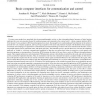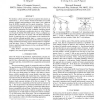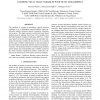281 search results - page 28 / 57 » Peer-to-Peer Application Recognition Based on Signaling Acti... |
CACM
2011
12 years 11 months ago
2011
For many years people have speculated that electroencephalographic activity or other electrophysiological measures of brain function might provide a new non-muscular channel for s...
ICASSP
2009
IEEE
14 years 2 months ago
2009
IEEE
We introduce a direct model for speech recognition that assumes an unstructured, i.e., flat text output. The flat model allows us to model arbitrary attributes and dependences o...
CSL
2008
Springer
13 years 7 months ago
2008
Springer
Active learning (AL) is a framework that attempts to reduce the cost of annotating training material for statistical learning methods. While a lot of papers have been presented on...
WWW
2004
ACM
14 years 8 months ago
2004
ACM
The ability to determine what day-to-day activity (such as cooking pasta, taking a pill, or watching a video) a person is performing is of interest in many application domains. A ...
ICASSP
2011
IEEE
12 years 11 months ago
2011
IEEE
The problem of acoustic-to-articulatory speech inversion continues to be a challenging research problem which significantly impacts automatic speech recognition robustness and ac...



